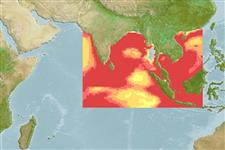Environment: milieu / climate zone / depth range / distribution range
Ökologie
seewasser; brackwasser; ozeanodrom (Ref. 51243); tiefenbereich 0 - 50 m (Ref. 189). Tropical; 25°N - 9°S, 69°E - 117°E (Ref. 189)
Indo-West Pacific: western coast of India to Myanmar and south to Java, Indonesia.
Length at first maturity / Size / Gewicht / Alter
Maturity: Lm 13.0 range ? - ? cm
Max length : 19.0 cm TL Männchen/unbestimmt; (Ref. 55634); 20.5 cm TL (female); max. veröff. Gewicht: 60.70 g (Ref. 55634); max. veröff. Gewicht: 60.70 g
Rückenflossenstacheln (insgesamt) : 0; Afterflossenstacheln: 0; Afterflossenweichstrahlen: 29 - 37. Belly with 24 to 32 keeled scutes from isthmus to anus. Tip of snout on a level with eye center. Maxilla long, reaching to or almost to base of first pectoral fin ray; first supra-maxilla oval, minute. Lower gill rakers with serrae on the inner edge even and not clumped. A dark blotch behind upper part of gill opening.
Found in coastal pelagic waters and often observed as entering mangroves and adjacent brackish waters (Ref. 43081). Juveniles and adults may penetrate the upper reaches where mixohaline-mesohaline conditions prevail. Eggs and larvae are found in the lower reaches of the mangroves (Ref. 43081). A schooling species found mostly inshore. Feed on planktonic organisms in coastal waters (Ref. 43081). Juveniles in mangroves feed on larvae of shrimps and fish (Ref. 43081). Confusions in identification make all previous biological studies unreliable. One of the commonest species of Thryssa (if identifications have been correct).
Wongratana, T., T.A. Munroe and M. Nizinski, 1999. Order Clupeiformes. Engraulidae. Anchovies. p. 1698-1753. In K.E. Carpenter and V.H. Niem (eds.) FAO species identification guide for fishery purposes. The living marine resources of the WCP. Vol. 3. Batoid fishes, chimaeras and bony fishes part 1 (Elopidae to Linophrynidae). FAO, Rome. (Ref. 9822)
IUCN Rote Liste Status (Ref. 130435)
Bedrohung für Menschen
Harmless
Nutzung durch Menschen
Fischereien: kommerziell
Tools
Zusatzinformationen
Download XML
Internet Quellen
Estimates based on models
Preferred temperature (Ref.
123201): 26.8 - 29.2, mean 28.6 °C (based on 648 cells).
Phylogenetic diversity index (Ref.
82804): PD
50 = 0.5000 [Uniqueness, from 0.5 = low to 2.0 = high].
Bayesian length-weight: a=0.00603 (0.00375 - 0.00968), b=3.02 (2.89 - 3.15), in cm total length, based on LWR estimates for this species & (Sub)family-body (Ref.
93245).
Trophic level (Ref.
69278): 3.6 ±0.6 se; based on diet studies.
Generation time: 1.4 ( na - na) years. Estimated as median ln(3)/K based on 1
growth studies.
Widerstandsfähigkeit (Ref.
120179): hoch, Verdopplung der Population dauert weniger als 15 Monate. (K=0.76).
Fishing Vulnerability (Ref.
59153): Low vulnerability (18 of 100).
